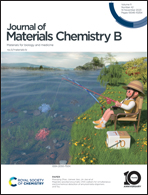Transfer-based nuclear magnetic resonance uncovers unique mechanisms for protein–polymer and protein–nanoparticle binding behavior†
Abstract
Nanoparticle-based drug delivery systems have shown increasing popularity as a means to improve patient outcomes by improving the effectiveness of active pharmaceutical ingredients (APIs). Similarly, nanoparticles have shown success in targeting alternative routes of API administration, such as applying mucoadhesion or mucopenetration to mucosal drug delivery to enhance uptake. While there are many promising examples of mucoadhesive nanomedicines in literature, there are also many examples of contradictory mucoadhesive binding behavior, most prominently in cases using the same nanoparticle materials. We have uncovered mechanistic insights in polymer–protein binding systems using nOe transfer-based NMR and sought to leverage them to explore nanoparticle–protein interactions. We tested several polymer-coated nanoparticles and micellar polymer nanoparticles and evaluated their binding with mucin proteins. We uncovered that the composition and interaction intimacy of polymer moieties that promote mucin binding change when the polymers are incorporated onto nanoparticle surfaces compared to polymer in solution. This change from solution state to nanoparticle coating can enable switching of behavior of these materials from inert to binding, as we observed in polyvinyl pyrrolidone. We also found the nanoparticle core was influential in determining the binding fate of polymer materials, whereas the nanoparticle size did not possess a clear correlation in the ranges we tested (60–270 nm). These experiments demonstrate that identical polymers may switch their binding behavior to mucin as a function of conformational changes that are induced by incorporating the polymers onto the surface of nanoparticles. These NMR-derived insights could be further leveraged to optimize nanoparticle formulations and guide polymer-mediated mucoadhesion.



 Please wait while we load your content...
Please wait while we load your content...